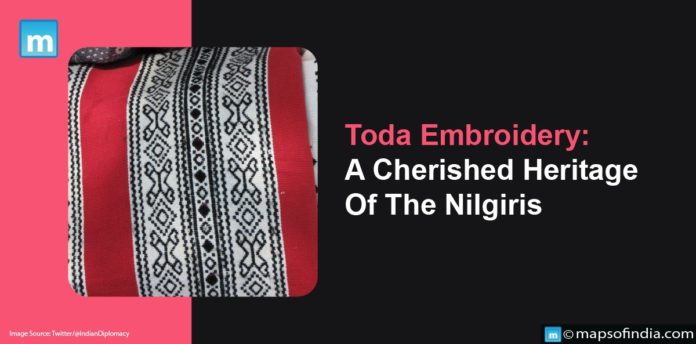Nestled in the picturesque Nilgiri Hills of Southern India, the Toda people have a rich cultural heritage that includes their unique and exquisite form of embroidery. Toda embroidery is a cherished tradition that reflects the artistic prowess of the Toda community and holds cultural and historical significance.
History of Toda Embroidery
Toda embroidery has a long and illustrious history dating back over a thousand years. The Toda people, a Dravidian ethnic group, live in the Nilgiri Hills, primarily on the Nilgiri Plateau, and embroidery is an integral part of their culture. While the exact origins of Toda embroidery are unknown, it is thought to have evolved organically from the community’s daily life and rituals. This art was traditionally passed down through generations, with women playing an important role in preserving and developing the technique.
Types of Toda Embroidery
-
Pukhoor
Pukhoor is a highly specialized type of Toda embroidery primarily used to decorate traditional Toda shawls known as “pudavai.” The pudavai is a rectangular, usually red or black fabric with intricate embroidery on both ends. Pukhoor is famous for its geometric patterns, which are painstakingly hand-embroidered with white and red threads. The designs frequently include triangular motifs, which create a stunning visual effect.
-
Thar Embroidery
Thar embroidery is more commonly seen in Toda society. Its simplicity is characterized by using red and black threads on a plain cloth. Thar embroidery can be found on traditional Toda clothing, such as shawls and headwear. It frequently uses simple motifs such as lines, dots, and shapes. This embroidery style exemplifies the Toda people’s minimalistic and elegant aesthetic.
-
Materials and Techniques
Toda embroidery is done on various fabrics, such as cotton, wool, and silk. The chain stitch, satin stitch, and backstitch are the most commonly used stitches. To create their vibrant colors, Toda embroiderers use a variety of natural dyes.
The reverse stitching technique is one of the most distinguishing features of Toda embroidery. The embroiderer works on the back of the fabric to raise the design on the front in reverse stitching. This technique produces a rich, embossed look.
-
Designs and Motifs
Toda embroidery designs and motifs are profoundly symbolic and reflective of the Toda way of life. While Pukhoor mainly comprises geometric patterns like triangles and rectangles, these designs have important cultural meanings. The triangles, for example, represent the Toda people’s sacred mountains. Thar embroidery, on the other hand, employs simpler motifs such as dots, lines, and squares to reflect the Toda culture’s simplicity and purity.
The motifs also honor the Toda’s close relationship with nature by incorporating animals, flowers, and the environment. These motifs evoke the Toda philosophy’s sense of harmony and coexistence with the natural world.
Toda Embroidery in the Modern World
Toda embroidery is still practiced by many Toda women today. The craft, however, is facing several difficulties. The increasing availability of mass-produced goods is one challenge. These items are frequently less expensive than traditional Toda embroidery and may appeal to consumers unaware of the value of Toda craftsmanship.
Another issue is the decrease in young people learning to embroider. Many young Toda people are migrating to cities for education and employment. As a result, there are fewer skilled Toda embroiderers. Despite these obstacles, several initiatives are underway to promote and preserve Toda embroidery. These initiatives include government programs, projects led by non-governmental organizations, and marketing cooperatives.
Conclusion
Toda embroidery is a unique and beautiful art form that is important to the Toda people’s cultural heritage. Their designs’ geometric patterns, natural motifs, and symbolic meanings make Toda embroidery a unique and cherished art form. It is not merely a decorative practice but a way for the Toda people to connect with their roots, express their beliefs, and sustain their way of life.




